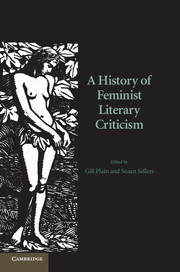Book contents
- Frontmatter
- Contents
- Acknowledgements
- Notes on contributors
- Introduction
- PART I PIONEERS AND PROTOFEMINISM
- PART II CREATING A FEMINIST LITERARY CRITICISM
- Introduction to Part II
- 6 Literary representations of women
- 7 A history of women's writing
- 8 Autobiography and personal criticism
- 9 Black feminist criticism
- 10 Lesbian feminist criticism
- 11 Men and feminist criticism
- PART III POSTSTRUCTURALISM AND BEYOND
- Postscript: flaming feminism?
- Index
- References
9 - Black feminist criticism
Published online by Cambridge University Press: 05 June 2012
- Frontmatter
- Contents
- Acknowledgements
- Notes on contributors
- Introduction
- PART I PIONEERS AND PROTOFEMINISM
- PART II CREATING A FEMINIST LITERARY CRITICISM
- Introduction to Part II
- 6 Literary representations of women
- 7 A history of women's writing
- 8 Autobiography and personal criticism
- 9 Black feminist criticism
- 10 Lesbian feminist criticism
- 11 Men and feminist criticism
- PART III POSTSTRUCTURALISM AND BEYOND
- Postscript: flaming feminism?
- Index
- References
Summary
What is generally understood to be black feminist criticism is a body of critical and creative work written by women of African descent in the United States. While black feminisms have arisen in other sites of the African diaspora, for example, in Europe and Latin America, the United States has been the site of the most sustained black feminist critical discourse. Contemporary black feminist criticism came into being in the late 1960s and early 1970s, fostered by the Civil Rights Movement and developed in conjunction with the Second Wave of American feminism, which was dominated by white women, and the Black Power and Black Arts movements, which were dominated by black men. Late twentieth-century black feminist critics and writers, like their white counterparts, have been invested in the connections between their present-day analyses and those of their foremothers in the eighteenth and nineteenth centuries; in other words, establishing a sense of continuity between black women's struggles and critical approaches to literature and culture in previous eras and in the present has been a foundational concern. Furthermore, a major thematic and structural element of black feminist criticism, from its roots in the era of slavery to the present, has been its simultaneous attention to multiple oppressions and multiple categories of analysis. From Frances Beale's concept of ‘double jeopardy’ (1970) – the conjoined effects of racial and gender discrimination – to Kimberlé Crenshaw's ‘intersectionality’ (1989/2000) – a more complex model of the ways in which black women function as a nexus at which several forms of discrimination work together – black feminist critics have articulated the layered effects of racism and sexism.
- Type
- Chapter
- Information
- A History of Feminist Literary Criticism , pp. 154 - 168Publisher: Cambridge University PressPrint publication year: 2007



